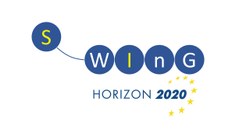Secure, clean and efficient Energy - SWInG
H2020-LCE
SWInG is an European project supported by the Horizon 2020program. The aim of this project is to develop wide band gap thin film solar cells based on kesterite absorbers for future application in high efficiency and low cost tandem photovoltaic devices. Among the partners there are laboratories, European R&D infrastructures and companies involved in material science and process development technologies. Some of them own records for CZTSe thin films technology. Among the participants are one university, four European research institutes and two European companies. The project duration is three years, starting from June 2015 till June 2018 and the project is coordinated by dr. Marc Meuris (Imec-Leuven).

Objectives
The motivations of SWInG project are:
- Development and optimization of a promising PV material based on kesterite materials
- Creation of the the capability of manufacturing tandem module solar panels with an efficiency above 30 %
- Obtaining, based on the wide band gap kesterite technology, a breakthrough for sustainable and non toxic TF-PV.
Role of Ghent University
The task of ELIS group (UGent) within the SWInG project is to perform advanced electrical and optical characterization techniques and to model the test devices that are produced by the other partners. Another aim is to develop a simulation model that can be used to describe the device performance, and also to indicate in which way kesterite and tandem PV solar cells can be improved.
Contact
Prof. Kristiaan Neyts, Prof. Jeroen Beeckman, Prof. Johan Lauwaert, Dr. Samira Khelifi
Liquid Crystals & Photonics group
Department of Electronics and Information Systems, Ghent University
Phone number: +32 9 264 3381
E-mail: kristiaan.neyts@ugent.be